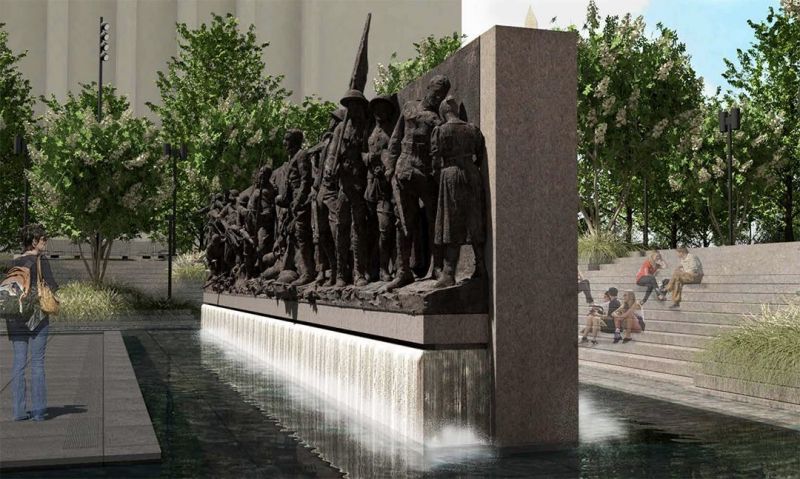
The design for the new National World War I Memorial on Pennsylvania Avenue in Washington, D.C., received final approval on Thursday from the U.S. Commission of Fine Arts (CFA).
“This is a day that all who have worked hard to bring the National World War I Memorial in Washington, D.C., from concept to reality are very happy to see,” said Terry Hamby, chairman of the U.S World War One Centennial Commission. “This final approval takes us a giant step toward beginning the construction of this long-overdue tribute in our nation’s capital to the 4.7 million Americans who served in America’s armed forces in World War I.”
The memorial design now goes for final review by the National Capital Planning Commission (NCPC). With the CFA and NCPC design approvals in hand, the commission will coordinate with the National Park Service to finalize the construction permit so that work can begin this fall to restore Pershing Park and build the memorial.
The memorial is being built under the commission’s authority by the Doughboy Foundation. In 2015, The American Legion passed a resolution supporting the memorial’s construction.
“This represents the ‘end of the beginning’ of fulfilling our sacred mission of honoring the doughboys, among whom were the founders of our beloved American Legion, with a fitting memorial in our nation’s capital,” said John Monahan, who serves as The American Legion’s representative on the U.S. World War One Centennial Commission. “Now we move on to the ‘beginning of the end’ — the construction of the memorial, which, with the financial support of Legionnaires and other citizens, will be realized in the foreseeable future.”
Key congressional sponsors of the legislation authorizing the centennial commission were also pleased.
“It’s important that we have a tribute in our nation’s capital to the millions of men and women who served during World War I so that future generations may come to understand the sacrifices made on behalf of liberty,” said Rep. Emanuel Cleaver, D-Mo. “This moment has been a long time coming, and I couldn’t be happier with the result.”
Former Rep. Ted Poe, R-Texas, hailed the approval decision. “All the doughboys and sailors of the Great War are gone, but now, after 100 years, America will trace their long patriotic journey through this magnificent memorial,” he said. “We shall remember them all, because the worst casualty of war is to be forgotten.”
The CFA’s design approval is the latest successful milestone in a five-year campaign that began in 2014 when Congress authorized the commission to construct in Pershing Park “appropriate sculptural and other commemorative elements, including landscaping, to further honor the service of members of the United States Armed Forces in World War I.” After an international competition in 2015 that received more than 350 entries from around the world, the design of architect Joseph Weishaar featuring a monumental bronze by sculptor Sabin Howard was selected as the winner from among five finalists.
“As the lead designer for this project, I’m proud to say that after four years of tireless effort we have at last achieved final approval for the design of the memorial,” Weishaar said. “This is possibly the greatest hurdle this project has had to overcome, and it is a testament to the enduring resolve that the World War One Commission and its supporters have in seeing this project through to completion. It’s been a long slough, but now it’s time to build a memorial!”
Howard added, “I am delighted beyond words to pass through this gate and be able to sculpt a memorial that will honor and uplift so many people across this nation.”
The memorial’s new monumental bronze, titled “A Soldier’s Journey,” is being sculpted in clay at Howard’s New Jersey studio, and will be cast in metal in the UK before being installed in the memorial park along with the existing sculpture of Gen. John J. Pershing, who commanded the American Expeditionary Forces in World War I. As well as the sculptural works in the park, the memorial will feature Extended Reality elements to enhance the visitor experience.
“One hundred years ago, 4.7 million American families sent their sons and daughters off to a war that would change the world,” said Dan Dayton, the commission’s executive director. “Finally, with this memorial, they will be recognized in the nation’s capital.”
A new document of the approved memorial design is available for viewing and download. The 80-page publication provides a detailed look at the new memorial from broad overview down to quotes that will be inscribed, surface and stone materials, what kind of plants will grace the park areas, the lighting plan, interpretive elements, handicap access and more.
Individuals and posts can donate to the memorial’s construction here.





